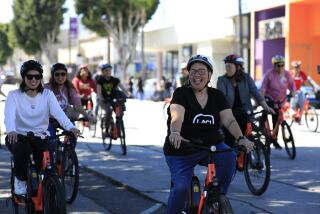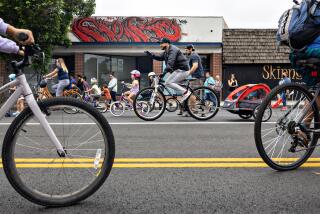Montreal by Bixi bicycle
Call me a tightwad, but when I heard that Montreal had rental bikes you can pick up and drop off all over town for a mere $5 Canadian a day (about $4.85 U.S.), it was like angels singing. See the city, sample the local cuisine and work it off without paying usurious day rates at the gym. This I had to try.
The bike system, called Bixi (think “bike” plus “taxi”), started last year in Montreal and proved so successful among both commuters and tourists that the technology has been exported to Minneapolis, London and Melbourne, Australia; Paris already has something similar. Boston and Washington, D.C., are to adopt Bixi systems this year.
Bixi bikes are heavy and sturdy, with just three gears and a narrow turning radius, so they’re not for racing or riding up, say, Mount Royal, the mountain park in the city center. For everything else, they’re pretty darn great. With some 5,000 bikes at 400 solar-powered, wirelessly linked stations throughout the city, a Bixi is rarely more than a few blocks away (at least in busier neighborhoods). They’re even a bit design-y: boomerang-shaped frame, wheel-powered generator for front and rear lights, front rack big enough for a small backpack, a tiny bell and an enclosure for the chain to prevent greasy pant legs. Montreal has about 280 miles of bike paths on streets, through parks and along waterways, including a part of La Route Verte, the Green Route through Quebec province.
Bixi does have its limits. It operates in only three seasons, avoiding the bitter cold and snow; this year, it’s scheduled to wrap up in November. Helmets aren’t provided, and because bike paths don’t go everywhere, the only option sometimes is to bike in traffic.
Then there’s the timing. Bixis must be returned within 30 minutes to avoid extra charges; timing is computer-monitored. The daily charge is $5.. For longer rides, it’s much like changing buses. You get off one bike and check out another. You must wait five minutes between Bixis.
How to Bixi
1. Find the nearest station on the pocket-sized fold-out Bixi map, available around town, or download the unofficial iPhone app.
2. Following the touch-screen guidance (in French or English), insert your credit card into the kiosk, select a plan, OK the terms and conditions and receive a five-digit code.
3. Choose a bike and enter the code to remove it from its slot.
4. When you’re done, return the bike to any Bixi station by inserting the front wheel into a slot. A green light will indicate that the bike has been returned. 5. To rent a bike again in the next 24 hours, swipe your credit card again to receive a new code. For more information, visit https://www.bixi.com.
My goal was to see as much as possible in 30-minute rides. It turned out to be an ideal way to explore the city’s markets and casual foodie finds.
First, though, I got my bearings with a three-hour cycling tour offered by Ça Roule, a standard bike shop. The shop is in Old Montreal, where French fur traders first settled, and the neighborhood still feels like France, though cycling its cobblestone streets was less than comfortable.
Outside of Old Montreal, the tour covered landmarks such as Buckminster Fuller’s geodesic sphere for the 1967 World Expo, Moshe Safdie’s landmark Habitat 67 housing project (both across the St. Lawrence River) and Notre-Dame Cathedral. We also rode north through the lovely Parc Lafontaine to the Plateau Mont-Royal neighborhood, block after block of row houses originally populated by working-class families. My guide told me that families of 14 were not uncommon back then, and that the houses’ long outdoor staircases helped maximize space inside. In recent decades, the Plateau has gentrified with professionals and artists, fashion boutiques and restaurants from ethnic to trendy; more on those later.
After the tour, I boarded a Bixi and headed west, docking first for lunch at Cluny ArtBar, serving healthy-sized sandwiches, coffees and desserts on tables recycled from bowling alley floors. It’s in the Darling Foundry, a former fire hydrant factory that’s been converted into galleries showing culture-clash-cool art installations amid old brick and pipes.
I picked up another Bixi and continued west to the Atwater Market, by way of the scenic bike path along the Lachine Canal. Industrial edifices such as the towering Five Roses flour mill across the canal give way to a tree-canopied waterside promenade where students snuggled and read.
The market, built in 1933, looks like a giant Art Deco barn topped by a clock tower. Stalls under the eastern eaves sell photogenic produce from beans to berries, while inside are equally camera-worthy terrines and pâtés, organic butcher shops and a sumptuous outpost of the Première Moisson patisserie. None of it is particularly cheap, but I guess photogenic costs. A few blocks northeast is an antiques district along Rue Notre-Dame, between Lévis and Vinet streets.
That night, I Bixied back to the Plateau for dinner at La Banquise, Montreal’s best known shop for poutine. This local specialty — French fries topped with gravy and cheese curds — is hearty, delicious and awesome with beer, though try as I might, all my photos made it look like dog food. None of the hipsters around me seemed to mind, with lines out the door, particularly after 3 a.m., when bars close. La Banquise tops the standard poutine dozens of ways, most pretty meaty. I chose Galvaude, with peas and shredded turkey, and was stuffed two-thirds of the way through.
The next morning, I Bixied through the Plateau to St-Viateur Bagel, whose bagels (sorry, New York) are the best in the world, especially when fresh from the oven, and poked around Schwartz’s for whiffs of another local specialty, smoked meat, such as hard-core pastrami.
The centerpiece of the day was the Jean-Talon Market, farther north near Montreal’s Little Italy. It’s as colorful as Atwater but less expensive, less touristed and more diverse: fruit-shaped marzipan pastries at the Ryad North African bakery, wispily fried calamari and éperlans (European smelts) at the stall Aqua Mare, and Quebec products such as maple syrup and maple pepper, jams, cheeses and dozens of microbrews at Le Marché des Saveurs.
I met a friend for lunch and later browsed Dante, which sells equipment for everything to do with food, from hunting ammo to goggles to use while chopping onions. Down the block, Anatol sells about 3,000 items in bulk. I found the usual (nuts, dried fruits, granolas) as well as the I-didn’t-know-they-made-that powdered cheese sauce.
The ride back downtown was the only leg of my journey that took longer than 30 minutes. No problem; after so much biking, I was grateful to take five midway. I docked the bike at Parc Lafontaine, realized I was at the start of the Green Route and wondered where else the trail might lead.
travel@latimes.com
More to Read
Sign up for The Wild
We’ll help you find the best places to hike, bike and run, as well as the perfect silent spots for meditation and yoga.
You may occasionally receive promotional content from the Los Angeles Times.






